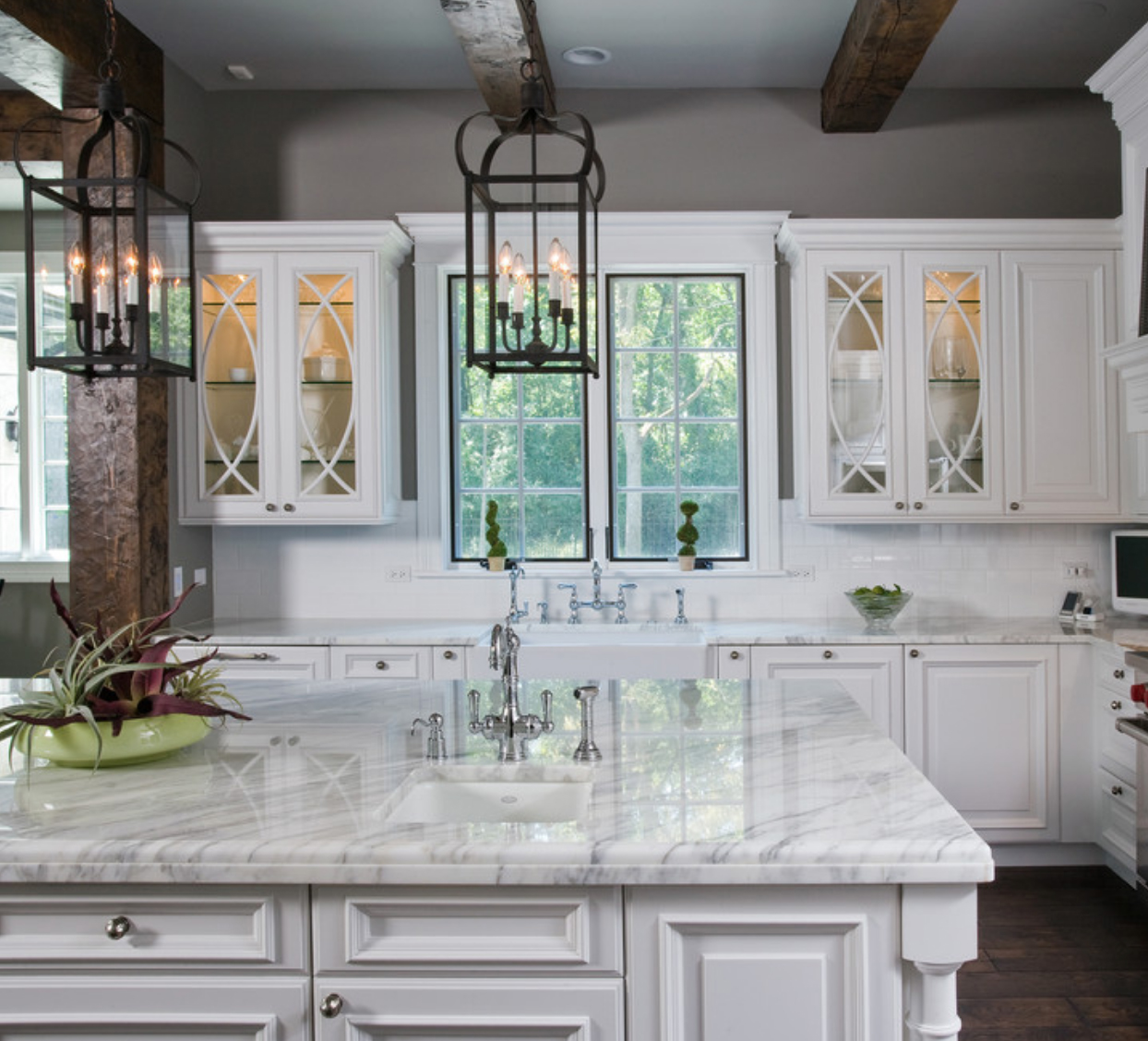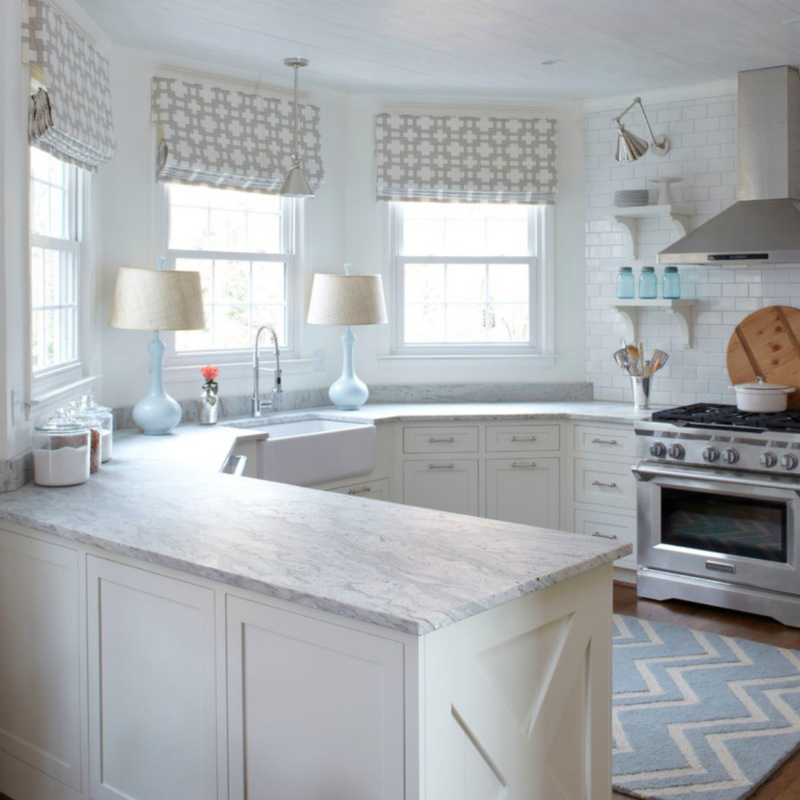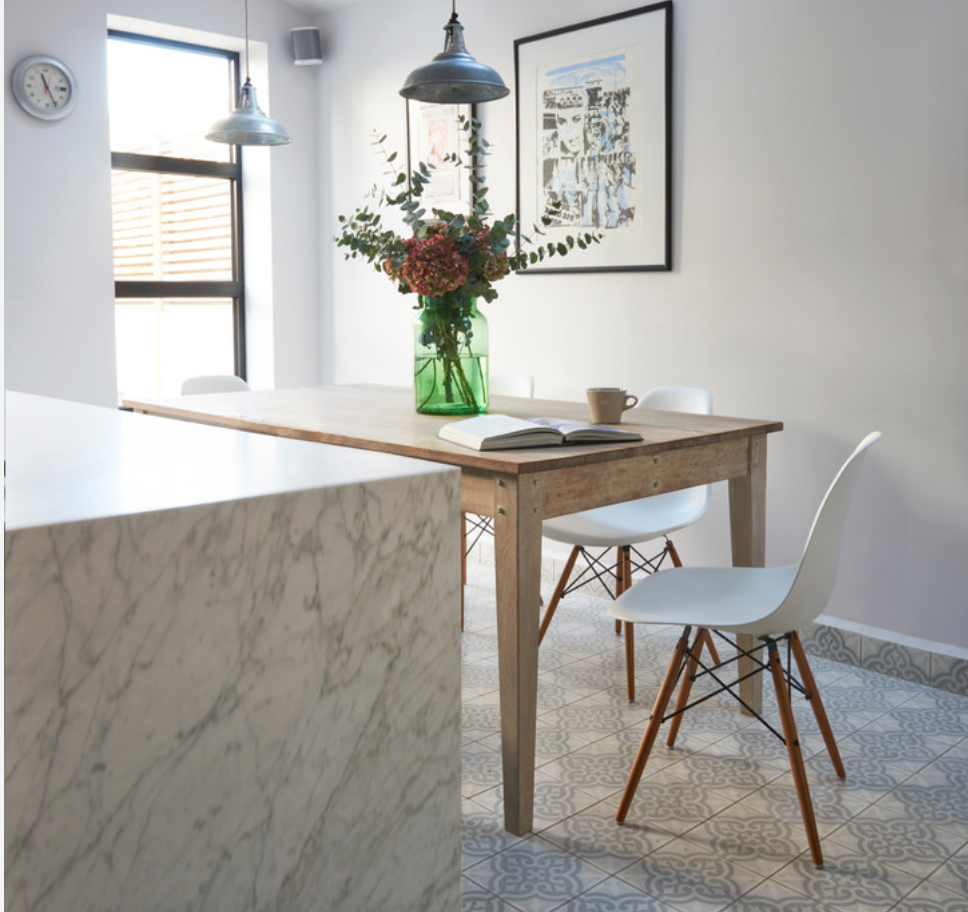Comparing Marble And Granite Countertops
September 28, 2019If you’re planning your “dream kitchen,” chances are that either marble or granite countertops are on your wish list — or you’re trying to decide between both options! Both have a reputation for upscale luxury and timeless beauty, and can even raise your home’s resale value.

Photo Credit: Houzz
It’s only fitting to compare the two, since they have a lot in common. Your choice may come down to looks, such as the available color options or patterns. You might also consider the cost of the slab that will form your countertop, or its country of origin. Your decision might be influenced by practical considerations such as maintenance needs, your family’s habits, or even your cooking style. Some homeowners have a vision of what sort of kitchen counters can be found in an “ideal” kitchen, and nothing else will do.
Whichever you choose, we want you to have plenty of information so you can be confident in your decision!
Composition
Marble and granite countertops are both natural stones which are mined from the earth. If you remember some details from your high school or college geology class, you can put that knowledge to use when comparing the two:
• Marble is a metamorphic rock — it is formed when limestone is subjected to intense pressure and heat. The calcite in limestone has been recrystallized and its texture has changed. Other minerals present in the rock give marble its color variations and veining.
• Granite is an igneous rock — it is formed when magma cools slowly underground. In this process, individual crystals of various minerals develop, such as quartz, feldspar, and mica. These crystals give granite its hardness and characteristic depth and sparkle.
Colors and Patterns
Marble colors tend to be subdued white, gray, or pale beige, although shades of green or blue are also available. The patterns range from subtle veining to bold stripes. The most common marble color is white with gray or beige veining. Different types of marble, such as Carrara, Calacatta, or Crema Marfil range in price and availability. Each marble slab is unique, which is one of the reasons natural stone is so highly treasured.

Photo Credit: Houzz
Granite countertops are available in a wider range of colors and patterns than marble. The various crystals and mineral composition lend granite its characteristic color variation, and it can be found in shades of orange, red, pink, gray, brown, and even blue and green. Like marble, each granite slab is unique — and since granite patterns tend to be bolder, homeowners should work with their supplier to select the exact slab they want in their kitchen or bathroom.
Finishes and Edges
Customizing your kitchen countertop with an edge profile is a popular option, though it does add extra expense. Both granite and marble can be given custom countertop edges such as beveled, rounded, ogee, and more. The finish you choose can also express your unique sense of style. Polished is the most common finish, but the matte look created by a brushed or leathered finish is growing in popularity, especially for marble.
Countries of Origin
Marble and granite countertops are sourced from all over the world. Your personal preference may influence the country of origin you prefer for your countertop. Although marble traditionally comes from Italy, today it may also be mined in Spain, Greece, Turkey, Egypt, and China. Granite originates from Brazil, Canada, India, and China. Typically, the farther your countertop needs to be shipped, the higher the cost, although this is not always the case.

Photo Credit: Houzz
Price
Installing a premium surface such as a granite or marble countertop offers excellent return on investment when it comes to increasing your home’s resale value, as well as your family’s own enjoyment. However, since few homeowners have unlimited budgets, it’s useful to compare the price of the two options.
• Marble is typically the more expensive countertop material, ranging from $50 to $150 per square foot, including installation costs. The price depends upon the type of marble — the more rare, limited-availability marble types such as Calacatta can cost much more than the more common marbles such as Carrara.
• Granite is slightly less expensive, ranging from $40 to $100 per square foot. Like marble, the cost depends upon the availability and rarity of the granite color; the more exotic colors cost more. The price can also go up for larger slabs rather than smaller pieces that are fit together.
Durability
Whether you plan to install your countertop in the kitchen or bathroom, durability is important. The kitchen, especially, can be used for many things besides cooking, such as kids’ school projects. Granite has the edge over marble here, because marble is a softer material more prone to staining and etching. Granite countertops are not indestructible, though; it is still prone to chipping and scratching if used improperly.
Repairing and specialized care
As with all types of natural stone, granite and marble need to be sealed regularly to maintain their resistance to water and other liquids. Lighter colors may need sealing more frequently than darker ones. Significant damage can be repaired, and in some cases, you may be able to do the job yourself using a repair kit from the hardware store. Large repairs may need professional service. Because of the patterning of a granite slab, repairs may be less visible on granite than on marble.

Photo Credit: Houzz
You might also wish to compare marble or granite vs. quartz, which can mimic both materials while needing significantly less maintenance. For example, quartz countertops never need sealing.
Daily Care
When properly sealed and maintained, both granite and marble can last for years — even decades. While marble is best cleaned using products designed specifically for marble and other natural stone, granite may be washed with any mild soap. For both types of countertop, make sure spills are wiped up right away and use protective pads, cutting boards, and trays to protect the counter from acidic, dark-colored, or oily liquids.
Both marble and granite countertops have devoted fans, including homeowners who have already made up their minds and will settle for nothing else. If you’re still trying to decide, however, be assured that both are excellent choices for many of the same reasons: durability, return on investment, and beauty just to name a few. Visit MSI’s web galleries to see the many types of marble and granite available for your own dream home.
Read More Granite Compared to Other Natural Stone Countertops
Granite, Quartz or Quartzite? Countertop Slab Materials in a Nutshell
Slate, Marble, Granite and Quartzite: 5 Natural Stone Tile Ideas
Natural Granite Vs. Marble Kitchen Countertops: Which Is Best?
READ MORE ABOUT GRANITE COUNTERTOPS
Bold and Beautiful Granite Colors
Comparing Polished, Honed, And Leathered Granite Countertop Finishes
Different Types Of Finishes For Granite Countertops
Does Luxury Vinyl Flooring Go Well with A Granite Countertop?